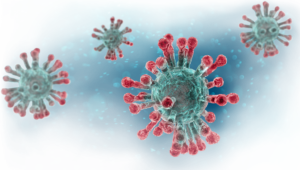Powering Relentless Science™
EOM613 has early clinical stage safety and efficacy data in various disease states. Below are examples of early exploratory stage safety and efficacy data in patients with AIDS, cancer cachexia, and rheumatoid arthritis.

Clinical Development Initiated and Planned
Patients are currently enrolled in R1: RESCUE, a Phase 1/2a open-label clinical study in Brazil evaluating EOM613 in severe hospitalized COVID-19 patients with “cytokine storm” immune responses
Further clinical development of EOM613 includes planning a Phase 2a mulitcenter trial for cancer cachexia in the U.S. and initiating exploratory trials for rheumatoid arthritis
Early Clinical Stage Safety and Efficacy Data for EOM613*
| Disease/ Disorder, Source | Study Type and Design | # of Patients | Efficacy Findings | Safety/Tolerability Findings |
|---|---|---|---|---|
| HIV/AIDS1 (Levett et al., 2002) | Study Type and Design
| # of Patients
| Efficacy Findings
| Safety/Tolerability Findings
|
| Rheumatoid Arthritis (RA)2 (EOM data on file) | Study Type and Design
| # of Patients
| Efficacy Findings
| Safety/Tolerability Findings
|
| Cancer Cachexia3 (Chasen et al., 2013) | Study Type and Design
| of Patients
| Efficacy Findings
| Safety/Tolerability Findings
|
*In these and other past reports, EOM613 has had other names, including Product R, OHR118, AVR118, and OHR/AVR118.
1
HIV/AIDS-Associated Cachexia
Levett PN, Hirschman SZ, Roach TC, Broome H, Alexander RJ, Fraser HS. Randomized, placebo-controlled trial of product R, a peptide-nucleic acid immunomodulator, in the treatment of adults infected with HIV. HIV Clin Trials. 2002 Jul-Aug;3(4):272-8. doi: 10.1310/N34A-653T-ABF5-8Q1R. PMID: 12187500.
2
Rheumatoid Arthritis. EOM Data on File.
3
Cancer Cachexia
Chasen M, Bhargava R, Hirschman SZ, Taraporewala I. Phase II study of OHR/AVR118 in anorexia-cachexia. Abstract of poster presentation at the 7th Cachexia conference, Kobe/Osaka, Japan, December 9-11, 2013. J Cachexia Sarcopenia Muscle 2013;4(4):335-6.
EOM147 is an investigational, broad-spectrum aminosterol with a unique intracellular mechanism for the treatment of retinal diseases. EOM147 affects multiple angiogenic growth factors such as VEGF, PdGF, and bFGF. This mechanism of action is uniquely differentiated from other retinal therapies that are only anti-VEGF and administered as an intraocular injection. The novel formulation, administered as an eye drop, represents a potential breakthrough that does not require intraocular injection.
Upcoming Clinical Trial of EOM147
EOM Pharmaceuticals is planning Phase 2 ophthalmic trials to be conducted for macular edema in patients with diabetic retinopathy and in wet age-related macular degeneration (wet-AMD) with the novel formulation of EOM147 to be conducted at sites in Mexico and India. The eye drop will be used as monotherapy, without adjunctive intraocular injections being administered.
An additional trial is planned for the use of EOM147 eye drop in branch and central retinal vein occlusions (BRVO and CRVO) in the United States, based on the promising results obtained in a previous investigator-initiated trial in 20 patients.
Completed Clinical Trials of EOM147*
| Disease/ Disorder, Source | Study Type and Design | # of Patients | Efficacy Findings | Safety/Tolerability Findings |
|---|---|---|---|---|
| Macular edema due to retinal vein Occlusion1 (Wroblewski and Hu, 2016) |
| 20 treatment-naïve patients | At week 38, best-corrected visual acuity improved mean best-corrected visual acuity significantly more in patients who continued squalamine vs stopped | Squalamine and ranbizumab were well tolerated |
*In this and other past reports, EOM147 has had other names, including OHR-102
1
Wroblewski JJ, Hu AY. Topical Squalamine 0.2% and Intravitreal Ranibizumab 0.5 mg as Combination Therapy for Macular Edema Due to Branch and Central Retinal Vein Occlusion: An Open-Label, Randomized Study. Ophthalmic Surg Lasers Imaging Retina. 2016 Oct 1;47(10):914-923. doi: 10.3928/23258160-20161004-04. PMID: 27759857.
Randomized, placebo-controlled trial of product R, a peptide-nucleic acid immunomodulator, in the treatment of adults infected with HIV. Levett PN, Hirschman SZ, Roach TC, Broome H, Alexander RJ, Fraser HS. HIV Clin Trials. 2002 Jul-Aug;3(4):272-8. doi: 10.1310/N34A-653T-ABF5-8Q1R. PMID: 12187500.
Anti-cachectic effects of a novel peptide nucleic acid: Preliminary results of a phase I/II clinical trial. D’Olimpio JT, Hirschman SZ, Shtemer Z, Didiego M. DOI: 10.1200/jco.2004.22.90140.8087 (presentation abstract). Journal of Clinical Oncology. July 15, 2004; 22, no. 14_suppl 8087-8087.
A Phase II study of OHR/AVR118 in anorexia-cachexia. Chasen M, Bhargava R, Hirschman SZ, Taraporewala IB. Poster presentation at: the 7th Cachexia conference, Kobe/Osaka, Japan, December 9-11, 2013.
Phase II study of the novel peptide-nucleic acid OHR118 in the management of cancer-related anorexia/cachexia. Chasen M, Hirschman SZ, Bhargava R. J Am Med Dir Assoc. 2011 Jan;12(1):62-7. doi: 10.1016/j.jamda.2010.02.012. Epub 2010 May 15. PMID: 21194662.
Activation of human monocytes/macrophages by OHR/AVR118 promotes both pro– and anti-inflammatory phenotypes. Hirschman SZ. Adv Biosci Biotch. 2014; 5:161-8.
Topical Squalamine 0.2% and Intravitreal Ranibizumab 0.5 mg as Combination Therapy for Macular Edema Due to Branch and Central Retinal Vein Occlusion: An Open-Label, Randomized Study. Wroblewski JJ, Hu AY. Ophthalmic Surg Lasers Imaging Retina. 2016 Oct 1;47(10):914-923. doi: 10.3928/23258160-20161004-04. PMID: 27759857.
IL-8 and MCP-1 secretion is enhanced by the peptide-nucleic acid immunomodulator, Product R, in U937 cells and primary human monocytes. D A Lazzarino, M de Diego, S Z Hirschman, K Y Zhang, S Shaikh, E Musi, L Liaw, R J Alexander. Cytokine. 2001 May 21;14(4):234-9. PMID: 11448124 DOI: 10.1006/cyto.2001.0867.
CXCR4 and CCR5 expression by H9 T-cells is downregulated by a peptide-nucleic acid immunomodulator. D A Lazzarino, M de Diego, E Musi, S Z Hirschman, R J Alexander. Immunol Lett. 2000;74(3):189-195. doi:10.1016/s0165-2478(00)00258-3.
Advanced Viral Research Corp (ADVR). ADVR reports AVR118 inhibits inflammatory arthritis in animal model and in rheumatoid arthritis patients in human clinical trial. ADVR press release, PR Newswire, December 3, 2003.